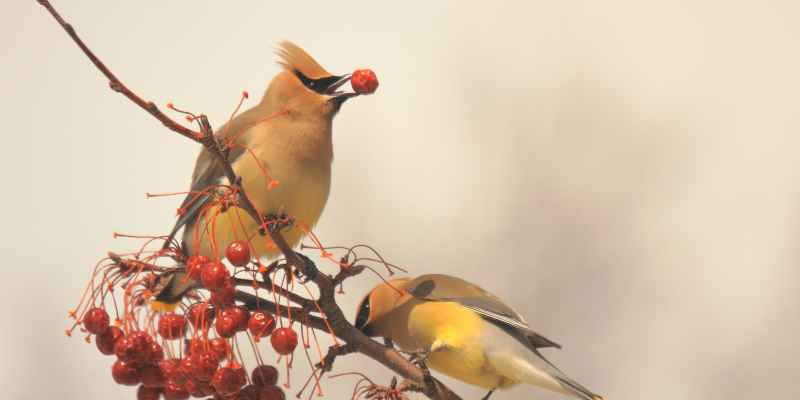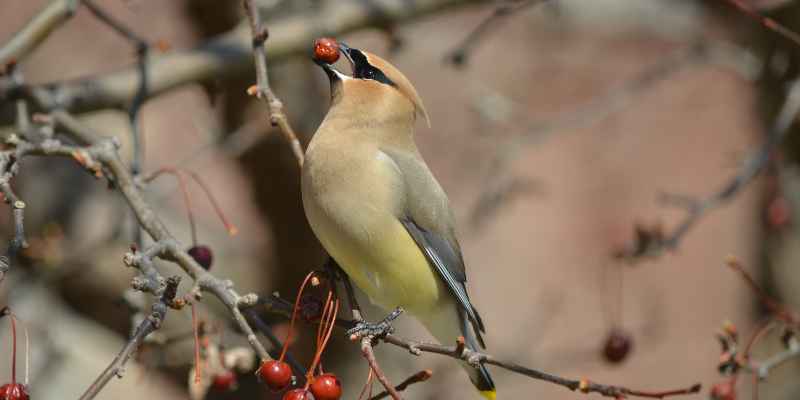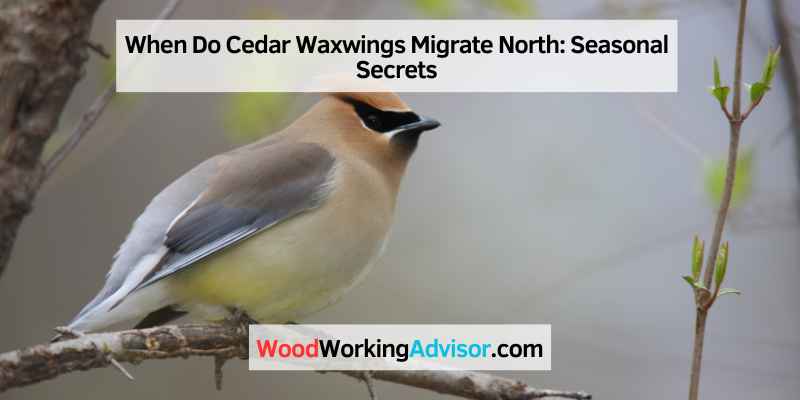Cedar Waxwings migrate north during the spring months, typically from March to May. These beautiful birds travel in search of breeding grounds and abundant food sources.
As the weather warms up, they venture northward, often in large flocks, creating a stunning sight for birdwatchers. Cedar Waxwings are known for their sleek plumage and distinctive black masks, making them easily recognizable among other avian species. Their migration patterns are influenced by factors such as temperature and food availability, driving them to move towards their northern destinations during the spring season.
Bird enthusiasts eagerly await the arrival of Cedar Waxwings as a sign of the changing seasons and the beauty of nature’s cycles.
Introduction To Cedar Waxwings
Cedar Waxwings are known for their distinctive appearance and graceful presence. These beautiful birds are native to North and Central America, captivating birdwatchers with their unique habits and behaviors. Let’s delve into their characteristics and habitat preferences to better understand these charming creatures.
Characteristics
Cedar Waxwings are easily recognizable due to their sleek, brownish-gray plumage and striking black masks outlined in white. Their wax-like red tips on the secondary feathers give them a distinct appearance, making them a joy to observe in the wild.
- Unique red tips on secondary feathers
- Black mask outlined in white
- Elegant brownish-gray plumage
Habitat Preferences
These migratory birds are often found in wooded areas, particularly in open woodlands, parks, and suburban gardens. They are attracted to fruiting trees and shrubs, where they feed on berries and small insects. Their preference for these habitats makes them a delightful sight for bird enthusiasts in these areas.
Migration Patterns Of Cedar Waxwings
Cedar Waxwings migrate north during late spring and early summer to breed in cooler regions. They travel in large flocks, seeking berries and insects along the way. These beautiful birds are known for their synchronized movements and melodious calls during migration.
Cedar Waxwings are known for their beautiful appearance and melodious songs. These birds are migratory, which means they travel to different regions at different times of the year. The migration patterns of Cedar Waxwings are fascinating, and they have been the subject of many studies. In this article, we will explore the triggers for migration, direction and distance of Cedar Waxwings’ migration.
Triggers For Migration
Cedar Waxwings are known to be triggered by the availability of food. When the food supply in a particular region becomes scarce, Cedar Waxwings start to migrate to other regions where they can find food. The primary food source for Cedar Waxwings is fruit, and they prefer to feed on fruit that is overripe.
Direction And Distance
Cedar Waxwings migrate in flocks, and they usually travel during the day. They are known to migrate in a north-south direction. In the spring, Cedar Waxwings migrate north to breed, and in the fall, they migrate south to escape the harsh winter conditions. The distance that Cedar Waxwings travel during migration varies depending on the location. In some cases, they can travel up to 2,000 miles during their migration.
Summary
In summary, Cedar Waxwings are migratory birds that travel to different regions in search of food. They are triggered by the availability of food, and they prefer to feed on overripe fruit. Cedar Waxwings migrate in a north-south direction, and the distance they travel varies depending on the location. Understanding the migration patterns of Cedar Waxwings is essential for their conservation and protection.
The Northern Journey
Cedar Waxwings migrate north during the spring season in search of breeding grounds and food sources. These beautiful birds embark on their northern journey, making their way to regions where they can find an abundance of berries and insects to sustain them.
Keep an eye out for these migratory marvels as they bring a touch of color and melody to the northern landscapes.
Timing Of The Northward Migration
Cedar Waxwings migrate north during the spring months.
They begin their journey in late March to early April.
Routes Taken
Cedar Waxwings follow the eastern and central flyways.
They travel from southern regions to northern habitats.
In the Northern Journey, Cedar Waxwings migrate north during spring, starting in late March to early April. They follow the eastern and central flyways, traveling from southern regions to their northern breeding grounds.
Seasonal Secrets Unveiled
Cedar Waxwings are fascinating birds that captivate birdwatchers with their unique migration patterns. Seasonal Secrets Unveiled sheds light on the mysterious timing of their northward migration.
Environmental Cues
Their migration north is influenced by environmental cues such as temperature changes and daylight length, triggering the instinct to travel in search of suitable nesting grounds.
Role Of Food Sources
The role of food sources is pivotal in guiding the Cedar Waxwings’ migration. They rely on the abundance of berries and fruits, which dictate their movement to areas with rich food supplies.
Challenges During Migration

Cedar Waxwings are remarkable birds known for their migratory behavior. However, their journey northward is not without its challenges. These birds face various obstacles that they must overcome in order to reach their breeding grounds successfully. Let’s take a closer look at the challenges that Cedar Waxwings encounter during their migration.
Predators And Hazards
During their migration, Cedar Waxwings encounter several predators and hazards that pose a threat to their survival. Predatory birds such as hawks and falcons are always on the lookout for a potential meal, and Cedar Waxwings need to be cautious to avoid becoming their prey. Additionally, terrestrial predators like snakes and mammals can also pose a danger to these small birds.
Moreover, human-related hazards, such as collisions with buildings and vehicles, also pose significant risks. As Cedar Waxwings navigate through unfamiliar territories, they may inadvertently collide with structures or vehicles, leading to injuries or even death. These hazards highlight the importance of raising awareness about bird-friendly practices and implementing measures to mitigate these risks.
Weather Conditions
Weather plays a crucial role in the success of Cedar Waxwing migration. Unfavorable weather conditions can significantly affect their journey, making it more challenging and potentially hazardous. Harsh winds, heavy rains, and storms can disrupt their flight patterns and disorient them, causing delays or forcing them off course.
Extreme temperatures, especially during spring migration, can also impact the availability of food sources for Cedar Waxwings. If their arrival coincides with a late cold spell, it can lead to a scarcity of insects and fruits, which are essential for their survival. These birds rely heavily on the availability of these food sources to replenish their energy levels during their long journey.
In conclusion, Cedar Waxwings face a range of challenges during their migration northward. These challenges include the presence of predators and hazards, as well as the unpredictability of weather conditions. By understanding these obstacles, we can appreciate the resilience and determination of these incredible birds as they overcome these hurdles to complete their annual journey.
Impact Of Climate Change
Cedar Waxwings migrate north in response to climate change, impacting their breeding and feeding patterns. As temperatures shift, these birds alter their migration timings, affecting ecosystems and food availability. Understanding these changes is crucial for conservation efforts and managing the impact of climate change on wildlife.
Shifts In Migration Timing
Cedar Waxwings migrate north due to climate change affecting their habitats. Warmer temperatures may alter migration timing impacting their breeding seasons.
Adaptations To New Conditions
Cedar Waxwings may adapt by adjusting their migratory routes or destinations. Climate change calls for behavioral and physiological adaptations.
Impact of Climate Change:
Cedar Waxwings face challenges with climate change affecting their migration patterns. Warmer temperatures lead to earlier migrations north impacting their reproductive success.
Shifts In Migration Timing
Cedar Waxwings may migrate earlier due to rising temperatures influencing food availability. Breeding success depends on timing of migration.
Adaptations To New Conditions
To cope, Cedar Waxwings may change migration routes or habitats to suit changing conditions. Behavioral shifts are crucial for survival.
Conservation Efforts
Cedar Waxwings typically migrate north in spring, following the blooming of their favored fruits like berries. Conservation efforts play a crucial role in protecting their habitats during this critical period. By safeguarding these areas, we can ensure the continued migration of Cedar Waxwings for generations to come.
Cedar Waxwings are beautiful migratory birds that spend their winters in the southern United States and Mexico. As spring approaches, these birds begin their journey northwards to breed and nest. However, like many migratory birds, Cedar Waxwings face a variety of threats along their migration routes. To ensure the survival of these amazing birds, a number of conservation efforts have been put in place. This article will focus on two main conservation efforts: protecting habitats and supporting research and monitoring.
Protecting Habitats
One of the most important conservation efforts for Cedar Waxwings is protecting their habitats. These birds require a variety of habitats, including forests, orchards, and other wooded areas, to breed and nest successfully. Unfortunately, many of these habitats are under threat due to deforestation, urbanization, and agriculture. To protect these habitats, a number of organizations are working to preserve and restore forests and other important habitats for Cedar Waxwings. In addition, efforts are being made to reduce the use of pesticides and other harmful chemicals that can negatively impact these birds and their habitats.
Supporting Research And Monitoring
Another important conservation effort for Cedar Waxwings is supporting research and monitoring. By studying these birds and their migration patterns, researchers can better understand the threats they face and develop strategies to protect them. To support this research, a number of organizations are working to monitor Cedar Waxwing populations and their habitats. This includes tracking their migration routes and identifying important stopover sites along the way. By understanding the biology and behavior of Cedar Waxwings, we can develop effective conservation strategies to ensure their survival.
In conclusion, Cedar Waxwings are amazing migratory birds that face a variety of threats along their migration routes. To ensure their survival, a number of conservation efforts have been put in place, including protecting their habitats and supporting research and monitoring. By working together to protect these birds and their habitats, we can help ensure that Cedar Waxwings continue to migrate north for generations to come.
Getting Involved
If you’re interested in birdwatching and want to get involved in tracking Cedar Waxwings’ migration north, there are several ways to do so. By participating in citizen science projects or creating bird-friendly spaces, you can help contribute to important research and conservation efforts.
Citizen Science Projects
Citizen science projects are a great way for birdwatchers of all levels to get involved in important research. By participating in these projects, you can help collect data on bird populations and migration patterns, which can then be used by scientists to better understand and protect these species.
One example of a citizen science project that tracks Cedar Waxwings is the eBird project, run by the Cornell Lab of Ornithology. By logging your Cedar Waxwing sightings on eBird, you can help contribute to a global database of bird observations that is used by scientists and conservationists around the world.
Creating Bird-friendly Spaces
If you want to do more to help Cedar Waxwings (and other bird species), consider creating bird-friendly spaces in your own backyard or community. Planting native trees and shrubs that produce berries and other fruits can provide important food sources for birds, while birdhouses and nesting boxes can provide shelter and nesting sites.
By creating bird-friendly spaces, you can help support Cedar Waxwings and other bird species throughout the year, not just during migration season.

Frequently Asked Questions
When Do Cedar Waxwings Migrate North?
Cedar Waxwings typically migrate north during the spring months, between March and June. They are known for their nomadic behavior, moving in flocks to search for food sources and nesting areas. Their migration timing can vary depending on factors such as weather conditions and availability of food.
Why Do Cedar Waxwings Migrate?
Cedar Waxwings migrate in search of food resources and suitable nesting habitats. They rely heavily on fruit-bearing trees, especially during the breeding season. Migrating allows them to follow the ripening of fruits and find areas with abundant food sources. It also helps to avoid harsh winter conditions in their breeding range.
How Far Do Cedar Waxwings Migrate?
Cedar Waxwings can cover considerable distances during migration. They are known to travel hundreds of miles, moving from their wintering grounds in the southern parts of their range to their breeding grounds in the northern regions. The exact distance can vary depending on the specific populations and their respective breeding and wintering ranges.
What Do Cedar Waxwings Eat During Migration?
During migration, Cedar Waxwings primarily feed on fruits, berries, and insects. They have a unique adaptation that allows them to digest and process large amounts of fruit, enabling them to rely on this food source during their journey. They are often seen foraging in flocks, consuming a variety of fruits from trees and bushes along their migration route.
Conclusion
Understanding the migration patterns of cedar waxwings is essential for birdwatchers and nature enthusiasts. By tracking their movements, we can appreciate the beauty and wonder of these birds. Observing their behavior can also provide valuable insights into the ecological changes that impact their migratory habits.
Stay tuned for more updates on these fascinating creatures.


